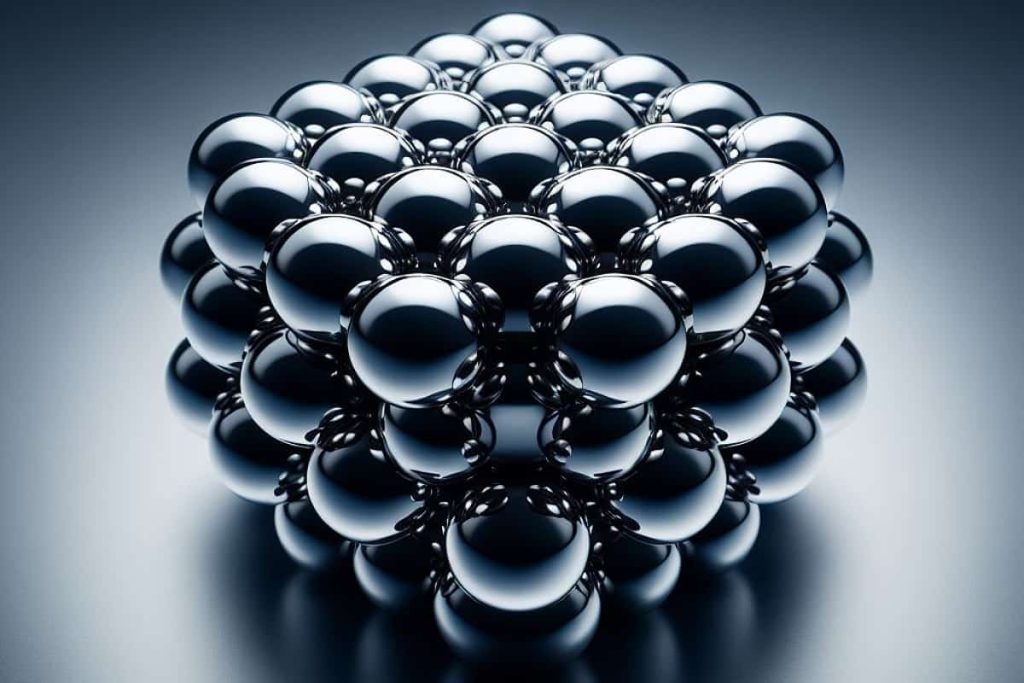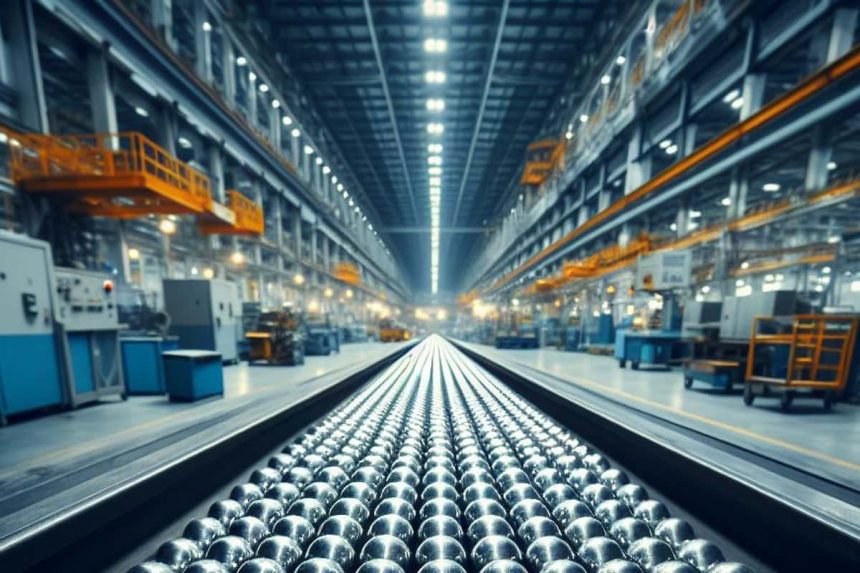In this article, we are going to answer the question of what are steel balls. Metal spheres, commonly known as stainless steel or metal balls, are typically produced through a process called cold forming. Their primary purpose is to enhance the performance of bespoke industrial metal goods and structures.
Available in an array of designs, materials, and configurations, these spheres find applications In various industries, including automotive, aerospace, beauty, animal feed, transport, and the oil and gas sector. Steel balls are integral to a multitude of industrial applications, catering to a broad spectrum of needs.
The type your project might require can generally be categorized as follows Solid Steel Balls
These are fully dense steel balls without any hollow sections, available in various stainless steel grades. Known for their wear resistance, longevity, and hardness, solid steel balls are offered in 300 and 400 series grades. Custom-grade options are also available to fulfill unique project specifications.
Carbon Steel Balls – Recognized for their sturdiness, dependability, wear resistance, and cost-effectiveness, carbon steel balls are hardened precision elements. They are a more economical choice than their stainless steel or aluminum counterparts and are commonly utilized in the creation of material handling systems, children’s toys, and aerosol cans for mixing purposes.
Chrome Steel Balls – Chrome steel balls, made from bearing-grade alloy steel, are renowned for their superior wear properties, surface quality, hardness, and strength. These alloy steel balls are employed in various industrial uses, including food processing equipment, valves, and more.
Food-Grade Stainless Steel Balls – Given the importance of food safety, food-grade stainless steel balls, particularly the 304H variety, are essential in food processing for grinding, blending, and mixing, ensuring no harmful residues are left behind.
read more: ball mill machines

Grades, Materials, and Dimension of steel balls
Stainless Steel Balls
Crafted through cold forming, stainless steel or metal balls enhance the functionality of tailored industrial metal products and assemblies. These spheres, varying in style, material, shape, and form, are utilized in numerous sectors, including automotive, aerospace, cosmetics, animal feed, transport, and oil & gas.
Frequently Utilized Steel Balls
Steel balls cater to a vast array of industrial applications. The type your endeavor might need typically falls under these classifications.
Solid Steel Balls – These are non-hollow, uniform steel balls available in various stainless steel grades. Notable for their wear resistance, durability, and hardness, they include the 300 and 400 series. Custom-graded balls can also be crafted for specific needs.
Carbon Steel Balls – These hardened precision balls are durable, reliable, wear-resistant, hard, and cost-effective. Less expensive than stainless steel or aluminum, they’re used in material handling equipment, toys, and aerosol cans for mixing.
Chrome Steel Balls – Bearing-grade alloy steel balls, known for outstanding wear, surface quality, hardness, and durability, are employed in food processing, valves, and other industrial uses.
Food-Grade Stainless Steel Balls – For food processing, 304H, or food-grade stainless steel balls, are essential for grinding, blending, and mixing without leaving harmful residues.
Steel Balls Grades, Materials, and Sizes
Steel balls are offered in various shapes and sizes, including the well-known 300 and 400 series, as well as other steel alloy compositions. Within these grades.
Industries and steel balls Uses
Stainless steel balls are integral components in various mechanical systems, ranging from vehicle parts to everyday household items like drawer slides. Their widespread use necessitates a broad spectrum of grades and sizes. Key industries that depend on steel balls include.
Agriculture Industry – Utilized in livestock feeding systems for animals such as chickens, turkeys, cattle, and pigs.
Automotive Industry – Employed in semi-precision and mechanical bearings within vehicles.
Automation Systems – Essential for automated mechanisms, steel balls facilitate movement and minimize wear.
Aerospace Industry – Integral to the development of instrumentation and locking mechanisms in aerospace devices and aircraft, and also used in bearings for airplane tires and landing gear.
Cosmetics – Featured in aerosol cans and cosmetic products, aiding in ingredient mixing due to their corrosion resistance and durability.
Food Processing Industry – Common in food processing, especially where corrosion resistance is crucial, and used in livestock watering and feeding systems as control valve balls for proper distribution.
Material Handling Industry – Incorporated into conveyor system ball bearings.
Other Industries – Including mining, transportation, oil & gas, energy, healthcare, and defense, all of which utilize various types of steel balls as described.
Steel balls are employed in a multitude of industries due to their unique properties and versatility.

Here are some principal uses
Bearings: Crucial for the manufacture of ball bearings, steel balls reduce friction and ensure smooth functioning in a variety of machines, such as automotive engines, industrial pumps, and conveyor. systems
Automotive Industry: In the automotive sector, steel balls are vital components in parts like steering systems, transmissions, and engines, where their ability to bear loads and resist wear and fatigue is essential for reliable. operation
Aerospace Industry: Steel balls are used In the aerospace industry for aircraft engines, landing gear, and control systems, where their durability under high temperatures, pressure, and tough conditions is. Invaluable
Machinery and Equipment: Steel balls are key elements in industrial machinery, found in valves, couplings, gears, and more, where they facilitate movement, diminish friction, and improve efficiency.
Grinding and Milling: In the process of grinding and milling, steel balls are instrumental in crushing and mixing materials, contributing to the reduction of particle size and the blending of substances in industries like mining, pharmaceuticals, and ceramics.
What Are Steel Balls Made Of
The production of steel balls typically utilizes carbon steel or stainless steel, depending on the demands of their application. Carbon steel balls, known for their hardness and wear resistance, are ideal for heavy-duty and abrasive conditions. On the other hand, stainless steel balls are preferred in environments where corrosion resistance is paramount.
In terms of manufacturing, steel balls start as raw steel wire which is then transformed into a spherical shape through cold heading or hot rolling techniques. Following this, a heat treatment process is applied to improve their mechanical attributes like hardness and robustness. The final step involves precision grinding to refine the size and surface quality, ensuring the steel balls meet exacting standards.
FAQ
- How does a ball mill work, and what is its primary function in materials processing?
Answer: A ball mill operates by rotating a cylinder filled with grinding balls made of stainless steel or rubber. As the cylinder rotates, the balls inside it crush and grind the material fed into the mill, reducing it to an extremely fine powder. The primary function of a ball mill is to crush and grind materials to achieve the desired particle size, making it suitable for various industrial processes such as mineral processing, ceramics, and pharmaceuticals.
- What are the key components of a ball mill, and how do they contribute to its operation?
Answer: The main components of a ball mill include the cylindrical shell, grinding balls, and the material feed inlet and outlet. The hollow cylindrical shell rotates on its axis, causing the grinding balls inside to cascade and grind the material. The grinding balls, typically made of stainless steel or rubber, exert mechanical force on the material, breaking it down into finer particles. The material feed inlet allows for the introduction of raw materials into the mill, while the outlet facilitates the discharge of the finely ground material. Together, these components work in tandem to effectively crush and grind materials in a ball mill.
- How does the versatility of ball mills make them suitable for a wide range of industrial applications?
Answer: The versatility of ball mills stems from their ability to effectively crush and grind materials into fine particles, making them indispensable in various industries. For instance, in the mining industry, ball mills are used to grind ores and extract valuable minerals. In the cement industry, they are employed for grinding clinker and gypsum to produce cement. Similarly, in manufacturing, ceramics, and chemicals, ball mills play a crucial role in pulverizing raw materials into desired powders for further processing. Moreover, industries such as pharmaceuticals, cosmetics, and food processing utilize ball mills for blending, mixing, and refining ingredients to achieve specific product formulations. Thus, the adaptability and efficiency of ball mills make them essential equipment across diverse industrial sectors.
- How do ball mills contribute to the efficiency and productivity of various industrial processes?
Answer: Ball mills contribute significantly to the efficiency and productivity of industrial processes by providing a reliable method for size reduction and material refinement. Their ability to grind materials into fine powders with precise particle sizes enhances the quality and consistency of final products in industries ranging from mining to pharmaceuticals. Additionally, ball mills offer flexibility in operation, allowing for adjustments in parameters such as rotation speed, ball size, and grinding time to optimize process conditions and achieve desired outcomes. Furthermore, the robust construction and low maintenance requirements of ball mills ensure continuous and reliable operation, minimizing downtime and maximizing productivity in industrial settings. Overall, the efficient performance and versatility of ball mills make them indispensable tools for various manufacturing and processing operations, contributing to overall efficiency and productivity in industrial production.
- How does the ball milling method contribute to the production of extremely fine powders?
Answer: The ball milling method is renowned for its ability to produce extremely fine powders through the grinding process. This method relies on the collision between tiny rigid balls and the material inside a concealed container. As the balls collide with the material, they exert localized high pressure, leading to the fragmentation and grinding of the material into smaller particles. The repetitive impact and grinding action of the balls facilitate the reduction of particle size, ultimately resulting in the formation of nanometer-scale powders. The use of rigid balls and a controlled container environment ensures efficient and uniform grinding, contributing to the production of finely ground powders with precise particle sizes. Therefore, the ball milling method stands out as a highly effective approach for achieving fine particle sizes in various applications, from materials science to pharmaceuticals.
- What are the main categories of ball mills based on the process used in industrial grinding?
Answer: Ball mills can be categorized into different types based on the process used in industrial grinding. These categories include dryer mills, superfine ball mills, open-circuit mills, and closed-circuit grinding mills. Each type of ball mill utilizes specific processes and mechanisms to achieve the desired grinding outcome. For example, dryer mills are designed to dry and grind materials simultaneously, while superfine ball mills are specialized for producing exceptionally fine powders. Open-circuit mills allow for continuous grinding without classification of the product, whereas closed-circuit grinding mills involve classification of the product before it is discharged.
- What are the main types of ball mills based on the raw materials processed in industrial grinding?
Answer: Ball mills used in industrial grinding can also be classified based on the raw materials processed. Some of the main types include raw mills, cement ball mills, coal ball mills, steel slag ball mills, slag ball mills, quartz ball mills, and aluminum ash ball mills. Each type of ball mill is optimized for grinding specific types of raw materials, ranging from raw ores and minerals to industrial by-products and waste materials. These variations in ball mill types cater to different industries and applications, ensuring efficient and tailored grinding processes for diverse raw materials.


Leave a Reply